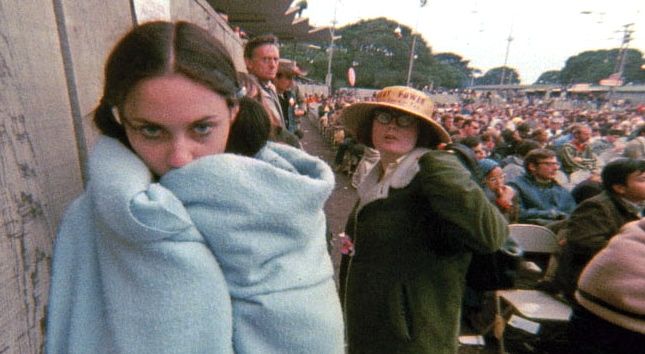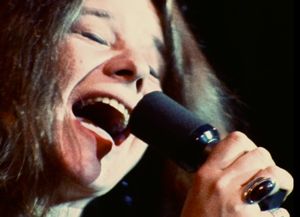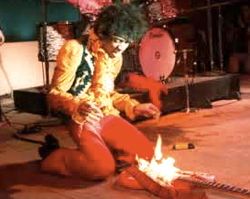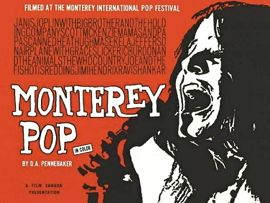
Monterey the rock festival still stands in the shadows of the unruly and iconic Woodstock, but “Monterey Pop” the film has no rival as a time capsule of late-’60s rock.
D.A. Pennebaker’s documentary was smarter, hipper and more musical than other rock films of the era. Yes, that includes the endlessly celebrated “Woodstock: 3 Days of Peace & Music,” recently tricked out on video for the fest’s 40th anniversary.
The Criterion Collection gave “Monterey Pop” its due back in 2006 with a carefully crafted DVD box set. Now, the connoisseur label is back with “Monterey Pop” in high definition video and lossless sound.
Disc 1 of Criterion’s Blu-ray box brings together a fully restored version of the original film and several hours of bonus performances. Disc 2 has the two spinoff films starring Jimi Hendrix and Otis Redding.
“The Complete Monterey Pop Festival” Blu-ray packaging is smaller but almost identical to the 2006 edition. (There were three discs on DVD, two here.) The beautiful booklet loses some visual impact, as it’s reduced by an inch or so all around.
Audio and video easily pass the acid test.
An A-B comparison of the Janis Joplin show-stopper “Ball and Chain” fairly dramatic, with the Blu-ray (DTS-HD MA) boasting a much more musical audio experience than the DVD.
The separation in original engineer Eddie Kramer‘s 5.1 mix felt even more vivid yet better balanced, while the instrumental shrillness that runs throughout the soundtrack was mitigated. Joplin’s voice had better presence and came across as much warmer than on the DVD.
I actually preferred the DVD audio on the Who’s “My Generation,” which had more balls and power than the Blu-ray rendition — distortion and blunt force being good things here.
Rear channels give off stadium ambiance, instrument echoes and audience cheers, making for an open, you-are-there vibe. Likewise, the HD video taken from the original 16mm negatives looks flower-child fresh, with almost none of the deterioration that plagued pre-2006 “Monterey Pop” videos.
The upgrade to high definition tamed the film’s grain a bit, but the 16mm stock clearly limits what could be done. (Audio and video on the outtakes have significantly rougher edges, including a lot of hair on the lenses. Imagine that.)
“Monterey” was, remarkably, the work of a filmmaker without a clue. New Yorker D.A. Pennebaker knew nothing of the bands he was filming or of the world-changing events unfolding before his cameras in 1967.
“I was the most ignorant person there,” Pennebaker recalls in his commentary. “It was a strange kind of Martian adventure for me.”
“Monterey Pop” captured the hippie music scene at a time closer to the Newport of Dylan than the chaos of the big Eastern rock fests. Many acts were folkies making the transition to rock, accomplished performers right at home on Monterey’s small traditional stage.
The mixed bag of performers included hitmakers the Mamas and the Papas, Simon and Garfunkel, Jefferson Airplane, Canned Heat, the Who and Buffalo Springfield.
Festival and film producer Lou Adler says Monterey provided the tipping point between the gentler “old guard” and the new wave of guitar-fueled psychedelia. “The film had a lot of the energy of what was coming,” he says in the bonus features.
No amount of rumor and speculation could convince the era’s biggest acts — notably the Beatles and Stones — to make the scene in Northern California, leaving the glory to a pair of mostly unknown performers: Janis Joplin and Jimi Hendrix.
The Blu-ray’s revved-up audio hints at the shock of the new fest audience experienced as Joplin stomped through “Ball and Chain” and Hendrix unleashed “Wild Thing.”
Time has been kind to many of Pennebaker’s creative decisions. The inclusion of international acts Hugh Masekela and Ravi Shankar gives the film a contemporary musical tone. Otis Redding makes the cut, not Lou Rawls. Editing avoids the frantic cuts of rock cliche.
In the bonus features, Pennebaker (“Don’t Look Back”) speaks at length about Indian musician Shankar’s raga that provides the thrilling but challenging finale. The plan that day was to focus on the audience reacting to the exotic Indian music, so Shankar’s stage cinematography was left to two inexperienced cameramen.
“It turned out to be the most extraordinarily dramatic piece of music we ever ran across,” the director recalls. During editing, Pennebaker says, he resisted pressure from Mama Cass Elliot to cut the lengthy instrumental, saying nothing could possibly follow it. Writer Truman Capote, of all people, encouraged Pennebaker to retain the number and the ensuing ovation that provides the film’s touching final moments.
The cinema verite enhances many of the film’s charms: When Eric Burdon sings “Paint It, Black,” Brian Jones walks among the crowd, unheralded. You either get it or you don’t — the camera moves on either way.
Adler, who partnered with Mamas and Papas frontman John Phillips to produce the festival, tells how a peace broke out between the rival rock factions of L.A. and San Francisco to facilitate the event.
Monterey was financed by network TV, with young ABC exec Barry Diller envisioning a musical special. Once fest organizers realized what they had, they deliberately screened Hendrix’s R-rated performance for the ABC suits — and were allowed to go elsewhere.
Lost in the purple haze of time, perhaps, are memories of the effect “Monterey Pop” had on cinema audiences of the day. Like “Rock Around the Clock” and “A Hard Day’s Night,” it signaled seismic shifts in the youth culture. This was the first authentic and uncensored look at the counterculture on the big screen, with the indie concert film arriving ahead of “Woodstock” and even “Easy Rider.” For those already in the groove, “Monterey Pop” provided visual confirmation of the power and pull of “underground” music and culture.
Outstanding outtakes on the Blu-ray set include Paul Butterfield, the Electric Flag, the Byrds and Laura Nyro. A bonus three-song segment from the Who features drummer Keith Moon at the peak of his crazed powers. The Mamas and the Papas close the show, and then the bonus section, with what would be their next-to-last concert.
Extras include audio interviews with the late Phillips and other key performers. Pete Townshend discusses his famous backstage mano-a-mano with Hendrix, and Tiny Tim performs in the green room, a piece of theater as trippy as anything ever cooked up in the psychedelic labs of Haight Ashbury.
Read more Blu-ray reviews on Screen & Stream.
- Related concert movie review: “The Last Waltz.”


